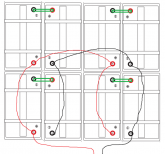Hi there, I'm trying to find out which is the best way to wire up my battery bank of 8 12v 225ah deep cycle gel batteries for a 24 v output which will achieve the most balanced load for charging and discharging without the need to swap around batteries so that any particular cell isn't overly stressed. I look around the internet but keep finding conflicting information about whether to use Parallel/Series or Series/Parallel. Could someone please enlighten me and put forward a diagram of most efficient method.
Many thanks in advance
Stu
Many thanks in advance
Stu







